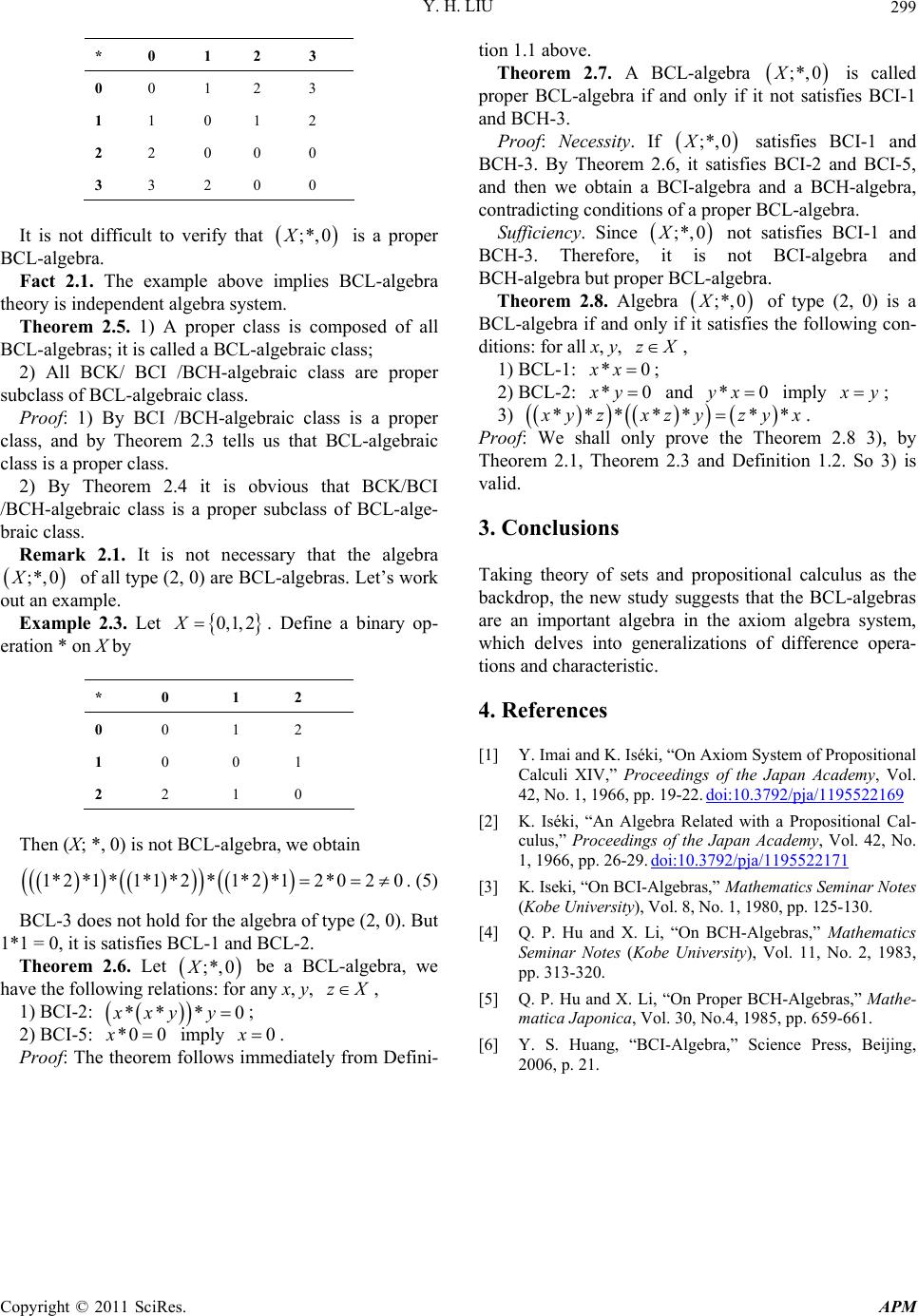
Y. H. LIU
Copyright © 2011 SciRes. APM
299
* 0 1 2 3
0 0 1 2 3
1 1 0 1 2
2 2 0 0 0
3 3 2 0 0
It is not difficult to verify that is a proper
BCL-algebra.
;*,0X
Fact 2.1. The example above implies BCL-algebra
theory is independent algebra system.
Theorem 2.5. 1) A proper class is composed of all
BCL-algebras; it is called a BCL-algebraic class;
2) All BCK/ BCI /BCH-algebraic class are proper
subclass of BCL-algebraic class.
Proof: 1) By BCI /BCH-algebraic class is a proper
class, and by Theorem 2.3 tells us that BCL-algebraic
class is a proper class.
2) By Theorem 2.4 it is obvious that BCK/BCI
/BCH-algebraic class is a proper subclass of BCL-alge-
braic class.
Remark 2.1. It is not necessary that the algebra
of all type (2, 0) are BCL-algebras. Let’s work
out an example.
;*,0X
Example 2.3. Let . Define a binary op-
eration * on X by
0,1, 2X
* 0 1 2
0 0 1 2
1 0 0 1
2 2 1 0
Then (X; *, 0) is not BCL-algebra, we obtain
1*2*1 *1*1 *2*1*2*12*020. (5)
BCL-3 does not hold for the algebra of type (2, 0). But
1*1 = 0, it is satisfies BCL-1 and BCL-2.
Theorem 2.6. Let
;*,0X be a BCL-algebra, we
have the following relations: for any x, y, ,
zX
1) BCI-2: ;
** *0xxy y
*0 0xx
2) BCI-5: imply .
0
Proof: The theorem follows immediately from Defini-
tion 1.1 above.
Theorem 2.7. A BCL-algebra is called
proper BCL-algebra if and only if it not satisfies BCI-1
and BCH-3.
;*,0X
Proof: Necessity. If
;*,0X satisfies BCI-1 and
BCH-3. By Theorem 2.6, it satisfies BCI-2 and BCI-5,
and then we obtain a BCI-algebra and a BCH-algebra,
contradicting conditions of a proper BCL-algebra.
Sufficiency. Since
;*,0X not satisfies BCI-1 and
BCH-3. Therefore, it is not BCI-algebra and
BCH-algebra but proper BCL-algebra.
Theorem 2.8. Algebra
;*,0X of type (2, 0) is a
BCL-algebra if and only if it satisfies the following con-
ditions: for all x, y, zX
,
1) BCL-1: *0xx
;
2) BCL-2: *xy 0
and imply
*0yx
y
;
3)
*** ****
yzxzy zyx.
Proof: We shall only prove the Theorem 2.8 3), by
Theorem 2.1, Theorem 2.3 and Definition 1.2. So 3) is
valid.
3. Conclusions
Taking theory of sets and propositional calculus as the
backdrop, the new study suggests that the BCL-algebras
are an important algebra in the axiom algebra system,
which delves into generalizations of difference opera-
tions and characteristic.
4. References
[1] Y. Imai and K. Iséki, “On Axiom System of Propositional
Calculi XIV,” Proceedings of the Japan Academy, Vol.
42, No. 1, 1966, pp. 19-22. doi:10.3792/pja/1195522169
[2] K. Iséki, “An Algebra Related with a Propositional Cal-
culus,” Proceedings of the Japan Academy, Vol. 42, No.
1, 1966, pp. 26-29. doi:10.3792/pja/1195522171
[3] K. Iseki, “On BCI-Algebras,” Mathematics Seminar Notes
(Kobe University), Vol. 8, No. 1, 1980, pp. 125-130.
[4] Q. P. Hu and X. Li, “On BCH-Algebras,” Mathematics
Seminar Notes (Kobe University), Vol. 11, No. 2, 1983,
pp. 313-320.
[5] Q. P. Hu and X. Li, “On Proper BCH-Algebras,” Mathe-
matica Japonica, Vol. 30, No.4, 1985, pp. 659-661.
[6] Y. S. Huang, “BCI-Algebra,” Science Press, Beijing,
2006, p. 21.